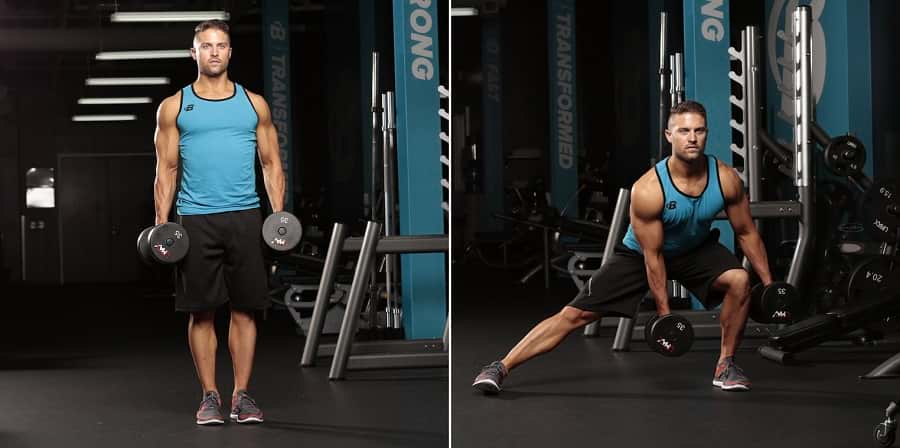Lunges are an efficient functional compound exercise. For this variation of the lunge, you are going to be stepping sideways instead of forwards or back.
Now stepping sideways is going to place significantly more work on your inner and outer thighs than the traditional lunge.
This version also requires you to have significantly more hip mobility. If you find you can not get your knee to a 90-degree angle, just go as far down as you comfortably can. With practice and time, your flexibility and mobility with the movement will continue to get better.
How to do Dumbbell Side Lunges
Video Demonstration
Image Example

Step by Step Description
Step 1: Grab a pair of dumbells in each hand and stand up straight. Put your feet approximately shoulder width apart. Turn the palms of your hands facing in towards your body. Put a small bend in your knees push your chest out and pull the shoulders back.
You are now in the starting position.
Step 2: Stay as upright as you can and face forward, now take a big step out to the side with your foot just slightly angled outwards. Keep your trailing leg straight and push your hips back and bend at your knee until your knee reaches a 90-degree angle.
Step 3: Now push the heel of your foot into the floor returning to the starting position.
Repeat this movement with the other leg to complete one repetition.
Difficulty Level
While this exercise may feel a little weird compared to the traditional version, it still has a small learning curve and gets rated at a beginner difficulty level.
Equipment Required
Like the title states for this variation of the side lunge, you are going to need a pair of dumbbells to hold in each of your hands.
Muscles Worked
The primary muscles involved with this lift are your Quadriceps, Inner Thighs, and Glutes.
The secondary muscles with this exercise are your Hamstrings, Calves, and Core.
Dumbbell Side Lunge Benefits
The Side Lunge is another form of unilateral training(trains one side of your body at a time). Training each party by itself helps you to find and correct any muscle imbalances that you may have developed between your two sides.
Side squats are commonly used by athletes to help them train lateral forces and occasional movements outside of linear domains.
Like most compound exercise a large number of muscles are required to work together to complete the movement. The more muscles involved, the higher amount of calories your body will burn. Using Compound movements is shown to be the best way to burn a significant number of calories in the shortest amount of time. Particularly when you include it as part of a High-Intensity Interval Training program, we offer a free online HIIT timer you can set up and start trying this lift in some high-intensity training today out.
Try not to let your knee of the leg you are bending, to go past the tip of your toe. When your knee goes out past the toe, additional stress gets placed on to your knee ligaments increasing your chance of a knee-related injury.
Training Tips
If you are having problems with not being able to reach proper depth practice without dumbbells and even hold onto something to help stabilize your body while you are learning to perfect your form.
Focus on keeping your shoulders pulled back, your back straight, head up, and make sure you do not let your lower back round.
A common mistake is for people just to bend their knee and not push the hips back. Focus on sticking your butt out and then bend at the knee. Not pressing your hips back reduces the amount of work done by the glutes.
In Closing
While the side lunge may not get as regularly used as the traditional version in local gyms, it has a lot to offer especially for people who are trying to increase there athletic performance.
They are an excellent way for you to gain some extra mobility in the hips and help weed out any muscle imbalances you may have in your lower body.
Looking to gain more strength or lose some weight? We offer free fitness tools to help you reach your fitness goals. Register for free while we are in beta and get free lifetime access to our fitness tools that include an easy to use Calorie Counter, High-Intensity Interval Timer, Multiple Fitness Calculators and our Exercise Logger.